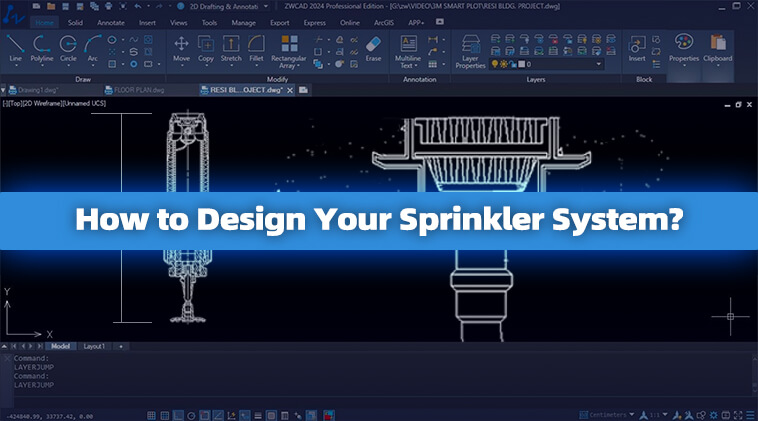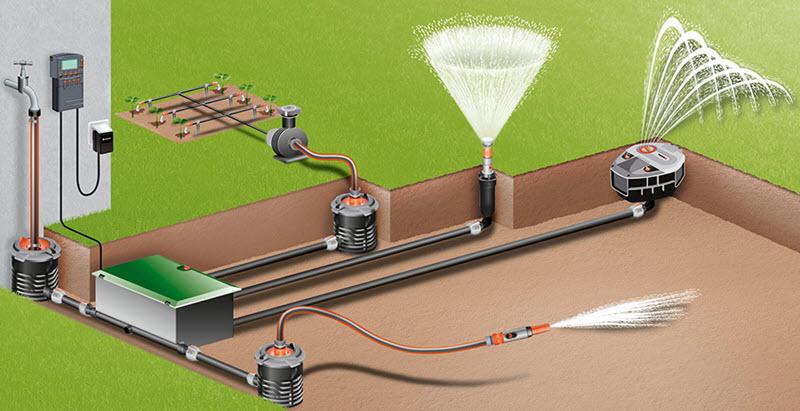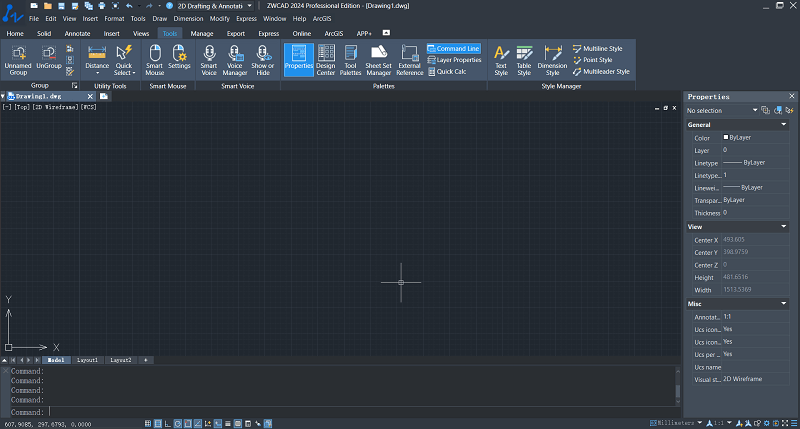For homeowners or businesses with extensive landscaping, it can be a challenge to maintain the health and appearance of the landscape. In this case, a sprinkler system can offer a convenient and efficient way to distribute water evenly across a designated area. This ensures that plants receive adequate moisture for healthy growth. Meanwhile, it helps minimize wastage due to runoff or evaporation.
The sprinkler system design guide here will lead you through what it is and the main types of sprinkler systems. Besides, a useful CAD tool will be introduced as well for anyone to streamline the process with great efficiency. Just don’t miss it.
| Related Article: |
Contents
- What Is Sprinkler System? What Are the Main Types of Sprinkler Systems?
- Step-by-Step Guide on Sprinkler System Design
- Best CAD Software for Sprinkler System Layout Design You Should Know
- FAQs About Sprinkler System Design
What Is Sprinkler System? What Are the Main Types of Sprinkler Systems?
A sprinkler system is a network of pipes, valves, and sprinkler heads designed to distribute water over a designated area for irrigation. It’s designed to provide efficient and even distribution of water to ensure that the designated area receives adequate moisture.
The system is typically connected to a water source, such as a water supply line or a well, and is controlled by a timer or an automated controller. In irrigation system design, sprinklers are used to deliver water to lawns, gardens, agricultural fields, and other landscaped areas. Here are a few ty[es that are commonly used.
| Types | Introduction | Application |
| Misting Sprinkler | A misting sprinkler sprays water in the form of fine droplets and is commonly used in scenarios that require a high level of water delicacy. | Gardens, greenhouses, and areas that require fine misting for plants. |
| Drip Irrigation | Drip irrigation releases small amounts of water directly to the plant’s roots for precise irrigation. It is suitable for plants that require controlled soil moisture. | Vegetable fields, orchards, areas that require precise targeted irrigation. |
| Pulse Sprinkler | A pulse sprinkler releases water in pulses and is commonly used in agricultural fields or large gardens to provide appropriate water volume and frequency. | Orchards, large agricultural fields, and areas that require timed irrigation. |
| Subsurface Irrigation | Subsurface irrigation is suitable for arid regions without conventional irrigation systems. It supplies water to plant roots through underground pipes and helps plants grow in water-limited environments. | Arid regions, areas lacking irrigation infrastructure. |
| Rotating Sprinkler | A sprinkler sprays water by rotating to cover a larger area. It is commonly used for large lawns or garden irrigation systems. | Large lawns, gardens, and landscape areas. |
| Fixed Sprinkler | A fixed sprinkler remains stationary and is suitable for areas that require targeted irrigation. | Flower beds, specific plant areas, border irrigation. |
| Half-Circle/Full-Circle Sprinkler | These types of sprinklers allow adjusting the water spray range as needed and are commonly used in areas with regular shapes to ensure full coverage of the designated area. | Flower beds, courtyards, and areas that require targeted irrigation. |
| Adjustable Sprinkler | Adjustable sprinklers allow people to adjust the water spray range and angle as needed with greater flexibility. They are suitable for various shapes and sizes of areas. | Diverse gardens, yards, and areas that require customized irrigation. |
| Multiple Flow Sprinkler | Multiple flow sprinklers have adjustable flow rates and are suitable for different water needs of various plants. Water flow can be adjusted based on the specific requirements of plants. | Planting areas with diverse water requirements, areas that need to accommodate different plant needs. |
Step-by-Step Guide on Sprinkler System Design
When it comes to designing a sprinkler system, there is a lot of work to undertake. Moreover, you should pay attention to the CAD importance in civil engineering. In some steps, using a CAD tool makes it easy for you to get things done. Now, let’s check out this sprinkler system design guide.
Step 1. Understand Plant Watering Needs for Efficient Irrigation
Determine the water requirements of the plants in your landscape. Consider factors such as plant type, growth stage, soil type, and local climate conditions. Some plants may require more water, while others may require less.
Step 2. Define Irrigation Zones for Optimal Water Distribution
Divide your landscape into irrigation zones based on plant water requirements and sun exposure. If necessary, divide the system into different zones, each with different irrigation requirements. Create a map or sketch to better understand the irrigation needs. This helps better control water usage, prevent waste, and improve efficiency.
Step 3. Consider Water Source and Pressure Management
Determine the water source for your sprinkler system, such as water, well water, or a water pump. Assess the available water pressure and flow rate to ensure proper functioning of the system.
Step 4. Select the Right Sprinkler Head Types for Effective Watering
Choose sprinkler head types based on the specific needs of each irrigation zone. Consider factors such as coverage area, precipitation rate, and adjustable features to meet the requirements of different plantings.
Step 5. Strategize Layout and Precise Placement of Sprinkler Heads
Use irrigation design software to create a sprinkler design layout. Then, plan the layout of sprinkler heads to maximize water distribution and minimize overspray or dry spots. Ensure proper head-to-head coverage by spacing the sprinklers appropriately.
Step 6. Install Main Controller and Valves for System Precision
Install a main controller that allows you to program watering schedules for each irrigation zone. Use valves to control the water flow to each zone for precise and efficient operation. Use valve boxes to protect the valves and ensure the system remains tidy when not in use.
Step 7. Execute Testing and Fine-Tuning for Seamless Operation
Test the sprinkler system thoroughly after installation to check for leaks, proper coverage, and adequate water pressure. Make any necessary adjustments, such as repositioning sprinkler heads or adjusting watering schedules, to achieve optimal performance.
Best CAD Software for Sprinkler System Layout Design You Should Know
ZWCAD is top-rated CAD software that enjoys a great reputation among engineers, architects, contractors, and building designers. It offers a range of tools for users of any skill level to draw and design sprinkler system layouts and piping networks in 2D. Then, you can render the design in 3D visualization for a lifelike inspection. Moreover, it provides measurement and annotation tools that enable you to accurately measure dimensions, add annotations, and mark important details on the design.
Meanwhile, ZWCAD allows you to create and customize symbols to streamline your design process and maintain consistency across projects. While supporting customization, it enables you to migrate applications easily with APIs including LISP, VBA, ZRX, and .NET. You can integrate it with GISkit BasisKaart developed by GISkit to facilitate the creation of sprinkler system designs in a simple and fast manner. Also, it supports multiple file formats like DWG, DXF, DWT, SAT, STL, PDF, IFC, etc., for seamless collaboration.
FAQs About Sprinkler System Design
How Do I Calculate How Many Sprinklers I Need?
You can follow the steps below to calculate how many sprinklers will be needed.
- Measure the length and width of the area to be irrigated.
- Consider the types of plants and their water requirements.
- Find information on the water requirements for the plants, and determine how much water is needed per square foot (or square meter).
- Measure the available water pressure and flow rate using pressure gauges and flow meters connected to the water source.
- Select the appropriate type and model of sprinkler heads.
- Use the basic formula to calculate the number of sprinkler heads required:
Number of sprinkler heads = (Total area x Water requirement per unit area)/(Flow rate per sprinkler head x Efficiency of the sprinkler head)
What Is the Formula for Irrigation Calculation?
The general formula is (width of your yard x length of your yard)*0.623.
You can calculate water use by multiplying the width and length of your yard in feet to get the number of square feet. Then, multiply the square footage by 0.623 (suitable for a typical lawn ) to determine the number of gallons used.
Note: Different plants have different water requirements.
Conclusion
Sprinkler system design is quite difficult. It involves considering various factors such as the size and shape of the area to be irrigated, the water requirements of the plants, the water pressure available, and the type of sprinklers to be used. With a great helper like ZWCAD, you can make everything easier.




